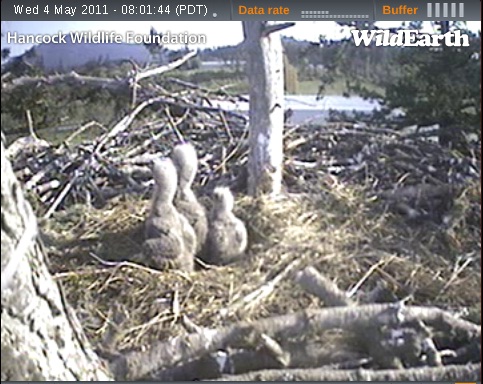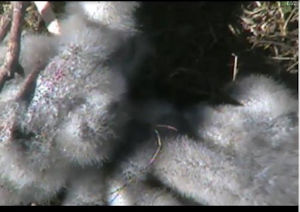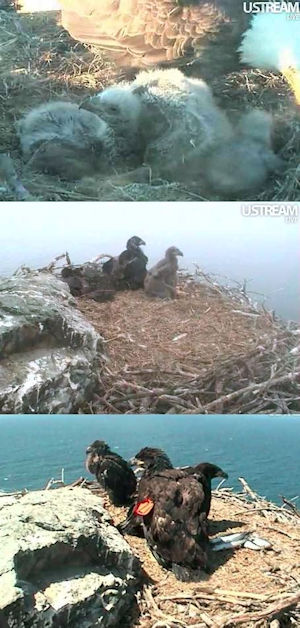
by Judy Barrows ("JudyB")
Originally published January 31, 2014, by Hancock Wildlife Foundation;
credits at the end; several of the images click larger.
I think everyone who has watched an eagle web cam for any length of time has probably noticed that while tiny eaglets are very cute - they really are not always warm/fuzzy little creatures. As a human who grew up with the slogan "make love, not war" - I do find it disconcerting when the tiny fluff-ball I've been ooh-ing and ah-ing over for a day or two suddenly turns towards its newly hatched baby sibling - and starts pecking! And I sometimes have a bit of a disconnect between the part of my brain that knows that a powerful feisty eagle will do well in the world - and the part of my brain that believes in consensus.
We've seen rivalry on the Hancock Wildlife cams from the beginning - back in 2006, the eaglet nicknamed Big and later named Victoria spent a lot of time attacking her younger brother, nicknamed Lil and later named Sidney or Sid. But it was all good in the end - Lil Sid learned how to snatch food away from the adults and swallow it whole before Big Vic had a chance to be fed - and they both fledged successfully. And I think they both learned skills on the nest that served them well in the future, hard as it was for us mere people to watch at times.
And that set a pattern of sorts - we saw older siblings who were quite brutal, and younger siblings who were quite clever - and all survived and thrived.
Until 2013. Last year, for the first time on a Hancock cam, we saw the dark side of rivalry, when little Bogey at Harrison Mills actually died.

And now we are starting a new season - beginning down south in North America, where two nests that we observe have chicks, and at least three more have eggs. As of the end of January, the two chicks on the Northeast Florida Eagle cam are almost 6 weeks old, and doing great! The two chicks on the Southwest Florida Eagle Cam are about 5-1/2 weeks old - and sibling rivalry has been a major issue. The collage below has two pictures from January 17, showing the size difference in eaglets only a day and a half apart in age, and showing the way the older one puts the younger in submission to avoid sharing food. The middle picture is from January 23, and shows the area of the younger eaglet's back where downy feathers were pulled out by the older. And the picture at the bottom is from January 29, and shows that the younger eaglet (with less dark feathers) is now [at time of writing] about the same size as the older, and both are peacefully sitting side by side waiting to be fed.
As a long-time observer of eagle cams (a friend posted about Hornby on a folk music forum back in 2006 - I looked at the cam - and was immediately hooked), I had the impression that rivalry was common - but rarely fatal. As someone who's analytical by nature - an impression wasn't good enough for me - so using the data I had readily available (the records I've been keeping since I started watching eagle cams), I did some analysis. The short answer is that my impression is right. Please keep reading for the longer answer and some additional pictures.
As a quick summary, I've been watching cams for 8 nesting seasons (2006-2013), and each year I discover and track more cams. I also follow the nests on the Channel Islands off the coast of California, where the Institute for Wildlife Studies has been working for years to return bald eagles to the islands. I started by discovering and following 17 nests in 2006 - and was tracking 49 in 2013. During those eight years, 399 chicks have hatched on the nests I've tracked - and 339 of those have fledged, which is about 85%. And that means that 60 chicks did not survive.
Eleven of those were at nests on the Channel Islands where we rely on regular visits by observers to determine what happened, and while they have excellent reports, I'm focusing on sibling rivalry, and that's not always obvious from watching for a couple of hours a couple of times a week, so I'm not including those 11 deaths in my summary. It's not always easy to find a primary cause of death, but I've come up with a rough summary as follows:
Aspergillosis - 1
Non-Eagle Predator (attacks by other eagles are under nest disruption) - 2
Weather (blizzards, heavy wind and rain, etc) - 6
Failure to Thrive (includes those who didn't recover from the work of hatching) - 7
Sibling Rivalry (either direct attacks or by keeping a younger eaglet from getting food) - 7
Fell from nest (poor nest construction, windy conditions, etc) - 8
Unknown or Other - 8
Nest Disruption (intruder, loss of adult, etc) - 10
There are some gray areas - I classified the loss ot #3/"Lil Bit" from Sequoyah 2012 as rivalry - but he was holding his own in spite of his smaller size until the weather turned bad, and he didn't have the feathers his older siblings did to protect him from the freezing rain. #3/"MeToo" at the West End nest in 2012 was also behind in development, but the weather was kind even if her siblings were not - and she fledged successfully, although several weeks later than her siblings. But even if a couple of the "unknown" deaths were directly or indirectly caused by sibling rivalry, that's less than 10 out of almost 400 chicks, or less than 2-1/2 percent.
It's harder to analyze the other side of the coin - the nests where there was serious rivalry, but everyone survived. This does make me think I may need another column on my yearly nest summaries (www.judyb-eagles.com/eagles2013/eaglet_info_2013.htm for instance), with check boxes or a sliding scale for sibling rivalry or unusual weather or other factors I might want to review quickly). Acknowledging that this is just a sampling, these are a few of the nests where I remember there being significant rivalry:
Sidney 2006,
with Big/Victoria and Lil/Sidney, as mentioned earlier.
Sidney 2009,
where older siblings Breeze and Hero regularly attacked youngest chick Tiny - and where Tiny learned to sneak under the adult who was feeding the chicks, and reach out to grab food from his or her beak, safe from the older chicks who couldn't peck her without pecking an adult - and was also the first to learn to self feed.
Sidney 2011,
where the oldest chick Flyer seemed to prefer attacking the two younger ones to eating, and there was a period of time where I wondered if any of them would survive; this rivalry was most severe for the first week or two, and seemed even worse because #3/Burrows was five days younger and much smaller than the ferocious eaglet attacking him.

Blackwater 2008,
where we wondered where the male had gone, until an observer from Europe reported that he was coming in at first light to take a brief turn brooding the chicks - and where the younger chick learned to circle around and move close to the adult from the side opposite the older chick, so he could get a share of the food; the smaller picture above on the right shows the chicks at about 4 weeks old, with the older sitting on the right, waiting to be fed - and the one and a half-day-younger sibling quietly moving up on the other side so he can also get a share

Pelican Harbor/Santa Cruz 2010,
where there was some fierce rivalry initially, which happily slowed down over time.
Richmond 2012,
where the chicks were also about a day and a half apart in age, and the older started attacking they younger before he was even a day old; the attacks grew worse the second week, with down being pulled out from the younger's head and back, and there was flooding on the rivers that were a primary source of fish, making food scarce; the picture to the left is when the chicks were about 10 days old, and the rivalry was the worst; you can see where the down is missing on the younger one, and some bleeding; happily fish deliveries picked up after this low point, and while there were a lot of challenges, both chicks fledged successfully in the end.

West End/Catalina Island 2012,
where the 4-day younger third eaglet was far enough behind that she couldn't be tagged with the others; the collage above on the left with three pictures shows the chicks at 17-16-12 days old when fish were plentiful and the rivalry not that bad yet; then when the two older ones were about 6 weeks old, and the younger was 5-1/2 weeks, and the rivalry was winding down; and on banding day, when the older chicks were 8 weeks old; that's one of my favorite pictures - because the youngest chick was too small for wing tags or the short-range transmitters most eaglets get at banding, she was quickly processed (blood test, general health check, and two leg bands) and returned to the nest - where a large pile of fresh fish had been left by the team from the Institute for Wildlife Studies. The younger chick, informally nicknamed "MeToo" by viewers had been getting a reasonable amount of food for a couple of weeks - but this is the one time we saw her crop truly filled to overflowing.

There have been a number of other instances, with varying levels of severity; these are the ones that come to mind quickly. In even the most peaceful nests, the bigger chicks occasionally put the younger into submission - and there are times that feisty younger chicks actually provoke the confrontation - I'm not sure which year, but do remember a third chick at Decorah who was a full week younger than the oldest chick going up to the big one and pecking - and eventually the big one noticed, and put the much younger one into submission with one well-aimed peck; that was a nest where we had worried about rivalry, but it never materialized - there was lots of food and experienced adults who knew that the tiny one needed more frequent feedings, and provided them while the older ones slept. I also remember a number of years ago at the NCTC/Shepherdstown nest when two chicks hatched close together, and the third arrived several days later; #1 regularly pecked at #2 to assert her first-place position, but they both pretty much ignored their much smaller sibling, who sometimes slipped between them and got fed, while they focused on pecking at each other.
So - in my experience, most eaglets do make it through the sibling rivalry experience stage - but it really does depend on a number of factors, such as the amount of food available, the age difference between the eaglets, the weather - and luck. Hopefully this will be a good year, when all the little ones not only survive, but thrive.
Additional References:
Summary of Eaglet Info 2006-2013
Apparent Causes of Eaglet Deaths 2006-2013
David Hancock's great article Sibling Rivalry - the Great Survival Technique
Photos (many click bigger): E3 and E4 from Southwest Florida, 2014, upper right photo courtesy of IrishEyes, cam courtesy of Dick Pritchett Real Estate; Birdie & Bogie, Harrison Mills, BC, 2013; Athena/K27, Megwich/K24 and Ge-nii ("MeToo")/5Z, West End nest, Catalina Island, CA, 2012, middle picture courtesy of urdognu, cam courtesy of Institute for Wildlife Studies; Intrepid & Destiny, Blackwater, MD, 2008; cam courtesy of Friends of Blackwater; Snuggles, Flyer & Burrows, Sidney, BC, 2011, courtesy of Lonette; R1 and R2 from Richmond VA, 2012, courtesy of urdognu, cam courtesy of the Center for Conservation Biology; other screen captures are mine.